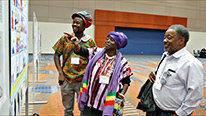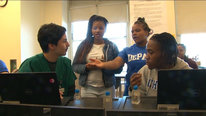- Beatriz Canas
- Program Manager Science Career Continuum
- Science First and College First: Connecting Chicago’s Youth to Local Environmental Priorities
- https://www.chicagobotanic.org/research/continuum
- Chicago Botanic Garden
- Julie Steffens
- Development Officer
- Science First and College First: Connecting Chicago’s Youth to Local Environmental Priorities
- https://www.chicagobotanic.org/research/continuum
- Chicago Botanic Garden
Science First and College First: Connecting Chicago’s Youth to Local Environm...
NE-00E02261
Beginning January 1, 2018, the Chicago Botanic Garden commenced work on an environmental education curriculum, funded by an award from the United States Environmental Protection Agency.
The Chicago Botanic Garden Science Career Continuum along with five Chicago community organizations and an experienced, Chicago-based curriculum writer, are in the process of creating and implementing curricula for the Science First II and College First programs. The programs focus on encouraging and supporting underrepresented students in the STEM fields. Students conduct hands-on scientific exploration and fieldwork exploring local environmental challenges related to air and water quality, toxic materials, green space, and climate change. After learning about these topics, students engage in community education days facilitated by the partner organizations, solidifying their knowledge and empowering them as experts.
The goal of the project is to contextualize science within communities familiar to students, making them aware of environmental issues that impact them. Further, the project sheds light on environmental hazards, which disproportionately affect communities of color, especially those that are also low-income.
Science First and College First: Connecting Chicago’s Youth to Local Environm...
NE-00E02261
Beginning January 1, 2018, the Chicago Botanic Garden commenced work on an environmental education curriculum, funded by an award from the United States Environmental Protection Agency.
The Chicago Botanic Garden Science Career Continuum along with five Chicago community organizations and an experienced, Chicago-based curriculum writer, are in the process of creating and implementing curricula for the Science First II and College First programs. The programs focus on encouraging and supporting underrepresented students in the STEM fields. Students conduct hands-on scientific exploration and fieldwork exploring local environmental challenges related to air and water quality, toxic materials, green space, and climate change. After learning about these topics, students engage in community education days facilitated by the partner organizations, solidifying their knowledge and empowering them as experts.
The goal of the project is to contextualize science within communities familiar to students, making them aware of environmental issues that impact them. Further, the project sheds light on environmental hazards, which disproportionately affect communities of color, especially those that are also low-income.
-
 Science Strikes Back: A New Community Science Fair
Science Strikes Back: A New Community Science Fair
R. Hougham
-
 Intergenerational Conservation STEM Learning and Identity
Intergenerational Conservation STEM Learning and Identity
Laura Rodriguez
-
 Community Perspectives On Noise Pollution
Community Perspectives On Noise Pollution
Makeda Cheatom
-
 Chicago Geospatial Semester Project
Chicago Geospatial Semester Project
Katie James
-
 Equitable & Consequential Making with Youth in Community
Equitable & Consequential Making with Youth in Community
Edna Tan
-
 Broadening Identities for Diverse Groups Engaging with STEM
Broadening Identities for Diverse Groups Engaging with STEM
Heidi Carlone
2575 Views
Continue the discussion of this presentation on the Multiplex. Go to Multiplex
2575 Views
presentation
has been viewed
Related videos you might be interested in...
-
 Science Strikes Back: A New Community Science Fair
Science Strikes Back: A New Community Science Fair
R. Hougham
-
 Intergenerational Conservation STEM Learning and Identity
Intergenerational Conservation STEM Learning and Identity
Laura Rodriguez
-
 Community Perspectives On Noise Pollution
Community Perspectives On Noise Pollution
Makeda Cheatom
-
 Chicago Geospatial Semester Project
Chicago Geospatial Semester Project
Katie James
-
 Equitable & Consequential Making with Youth in Community
Equitable & Consequential Making with Youth in Community
Edna Tan
-
 Broadening Identities for Diverse Groups Engaging with STEM
Broadening Identities for Diverse Groups Engaging with STEM
Heidi Carlone


MARY SPRAGGS
Thank you for your work! Everyone benefits from time spent in nature, and it's great to give the students the power to make a change in their local community/environment.
Beatriz Canas
Program Manager Science Career Continuum
Thanks, Mary! We are really proud of what our students have achieved.
Brian Drayton
Great project, and hurray for botanic gardens!
Is there something parallel for teachers (perhaps a plan for the future) — so that the great ideas infect the schools more and more widely?
Beatriz Canas
Program Manager Science Career Continuum
The Chicago Public Schools District administration and some high school teachers are aware of our program, but we do not directly influence curriculum at this time. It's a good idea, though!
Noah Feinstein
Associate Professor
I could not love this project more - you’ve got such a fantastic network of partners! Right now, I’m working with an arboretum to help develop and expand their educational programs, and it makes ,e think a lot about the way “informal education” conversations have focused too much on museums and not enough on other sorts of institution. What unique assets do you think a botanical garden - and this one in particular - add to this sort of work?
Beatriz Canas
Program Manager Science Career Continuum
Thanks, Noah! I would say our unique assets are our living collection and our staff scientists who are willing to mentor students. Where many museums work with students to become "explainers" on a museum floor, we have been able to put students into real science research and get a feel for what it would be like to pursue science as a career. Another asset is our connections with other organizations that share our environmental goals. These partners enable us to bring social justice issues into the learning experience in a powerful and meaningful way.
+ Reply
Noah Feinstein
Beatriz Canas
Program Manager Science Career Continuum
Thanks, Noah! I would say our unique assets are our living collection and our staff scientists who are willing to mentor students. Where many museums work with students to become "explainers" on a museum floor, we have been able to put students into real science research and get a feel for what it would be like to pursue science as a career. Another asset is our connections with other organizations that share our environmental goals. These partners enable us to bring social justice issues into the learning experience in a powerful and meaningful way.
Molly Phillips
This is an amazing! Does your program work with undergraduate students?
Beatriz Canas
Program Manager Science Career Continuum
Thanks, Molly! Our program is for high school students, but we do channel a few qualified alumni who are undergrads into the Research Experience for Undergraduates (REU) program in our science department. These undergrads actually work with some of our high school students so that there is a "near peer" mentorship opportunity, which we hope fosters community and encourages students to continue on their STEM pathway.
Molly Phillips
Molly Phillips
Great! Thanks so much for the response. The reason I ask is that we may be looking (pending funding) for partners from museums, herbaria, and botanic gardens to work on some internship programming targeted at undergraduates. I really like that you are integrating your programs by creating near peer mentor opportunities.
Beatriz Canas
Program Manager Science Career Continuum
Thanks, Molly! Our program is for high school students, but we do channel a few qualified alumni who are undergrads into the Research Experience for Undergraduates (REU) program in our science department. These undergrads actually work with some of our high school students so that there is a "near peer" mentorship opportunity, which we hope fosters community and encourages students to continue on their STEM pathway.
Noelia Báez Rodríguez
Hi Beatriz,
Thanks for communicating about your program! This is great work and love the community connection.
Rabiah Mayas
Associate Director
This is an exciting project, and as a Chicagoan, it resonates deeply - thank you for sharing this work with us! I appreciate the attention to the disproportionate impacts of environmental changes and hazards on populations and communities that have been marginalized. To what extent do the two programs build capacity in participants to be science communicators and ambassadors for environmental justice in the various contexts of their everyday lives? Are students joining clubs, seeking out other programs, participating in activism, etc. as a result of their participation? I'm curious if you've seen any evidence of this to date and any conclusions you might draw from that.
Beatriz Canas
Program Manager Science Career Continuum
Hi, Rabiah. These are very good questions. Last summer was the first year of this project, so most of our evidence is anecdotal at this point. The projects the students worked on were very strong and the students all expressed passion for the issues they investigated. In other words, we know there is a spark! We are hoping to see how this summer's returning students approach their second year of the program, and find out more about the effect of this program on their lives, and we will asks for annual updates in their academic and career choices, as well as other endeavors, after they graduate from our program.
Rabiah Mayas
Associate Director
Hi Beatriz, thank you for the reply! It's great to hear the students were passionate about their projects and it'll be exciting to explore the returning students' experiences since last summer! I missed the longitudinal check-in portion of this project; that should be a nice opportunity to monitor some of these key transition and decision moments.
Anne Kern
Associate Professor
Someone in the video mentioned that the youth programs have students study when they learn in school. I am curious about that. Do you intentional collaborate with teachers or classrooms of your student participants? How many youth are in your programs, and then how many classroom, and what do you do to work with teachers?
Beatriz Canas
Program Manager Science Career Continuum
Hi, Anne. We accept 60 students (about 20 at each level) and the students come from different schools around Chicago. We don't formally collaborate with teachers on curriculum, but we do see evidence of students bringing the things they learned in our summer program back to school and vice versa. Many students take their summer research and turn it into a science fair project. This year one student's summer project advanced to the Illinois State STEM Exhibition. Over time we have established relationships with some teachers and administrators who help us identify and recruit ideal students for our program.
Further posting is closed as the showcase has ended.